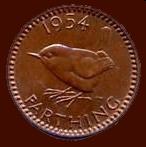








Designed by Nigel G Wilcox






The Paragon Of Metal Detecting
Powered By Sispro1
British Sterling Currency - Numismatics,
Groat
For Reference ONLY
Everything For The Detectorist
Charles I 1625-1649 AD
Royal Monarchy
Copyright All Rights Reserved by Nigel G Wilcox E-Mail: ngwilcox100@gmail.com
INFORMATION - DATA
Pages
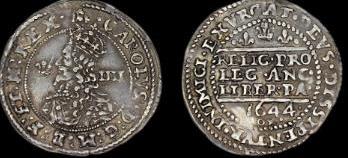
Groat
Top left - Charles I. (1625-1649) Groat, Plume in front of bust, ox below date.
Obverse: ·CAROLVS·D;G;M;B;F;ET·H;REX· bust left, crowned and mantled, plumes to left, [IIII to right].
Reverse: ·EXVRGAT·DEVS·DISSIPENTVR·INIMICI· surrounds, RELIG·PRO / LEG·ANG· / LIBER·PA· in three rows between two parallel lines. Plume above between two lis, ·I644· / ·OX· below.
Top Right - Weight: 1.96g, Diameter: 22.6mm, book, armour on shoulder & shorter collar, bust within circle left, mark of value behind, plume in front, rev. plume..
The second son of James I, King of Scotland and England, and Anne of Denmark, Charles was born a Scottish prince in Fife. He became heir to the throne following the death of his brother Henry. His manner was reserved - he suffered a residual stammer - and self-righteous. His refined tastes and love for the arts put a great deal of pressure on the royal budget, rapidly increasing the crown's debts. The other relevant aspect of his character, which hugely influenced contemporary events, was Charles' religiosity; he was a supporter of high Anglican worship which encouraged ritual and decorum. His marriage to Henrietta Maria of France, a Roman Catholic, added to his unpopularity.
Charles' reign began with an unhappy friendship with George Villiers, Duke of Buckingham, who used his influence against the wishes of other nobility. Buckingham was assassinated in 1628. Meanwhile, Charles had dissolved Parliament three times between 1625 and 1629 then chose to rule without summoning Parliament for 11 years. Unrest in Scotland - because Charles attempted to force a new prayer book on the country - put an end to his personal rule. Funds to quash the rebellion were limited and Charles was forced to call first the Short Parliament then the Long Parliament. Conflict in the House led to a foolish decision, prompted by Henrietta, to have five members arrested and civil war erupted.
In 1642 the royal standard was raised by Charles at Nottingham against the Parliamentary forces. The king's supporters, known as the Cavaliers, came from the ranks of peasants and nobility who fought against the militia drawn from the emerging middle classes, Puritans known as the Roundheads. Led by Oliver Cromwell, the New Model Army routed the Cavaliers at Naseby in 1645 and Charles surrendered a year later to the Scottish forces. In 1648 he was put on trail for treason and the king was found guilty by one vote (68 to 67) and his execution was ordered for 1649.
Obverse: ·CAROLVS·D;G;M;B;F;ET·H;REX· bust left, crowned and mantled, plumes to left, [IIII to right].
Reverse: ·EXVRGAT·DEVS·DISSIPENTVR·INIMICI· surrounds, RELIG·PRO / LEG·ANG· / LIBER·PA· in three rows between two parallel lines. Plume above between two lis, ·I644· / ·OX· below.
Top Right - Weight: 1.96g, Diameter: 22.6mm, book, armour on shoulder & shorter collar, bust within circle left, mark of value behind, plume in front, rev. plume..
The second son of James I, King of Scotland and England, and Anne of Denmark, Charles was born a Scottish prince in Fife. He became heir to the throne following the death of his brother Henry. His manner was reserved - he suffered a residual stammer - and self-righteous. His refined tastes and love for the arts put a great deal of pressure on the royal budget, rapidly increasing the crown's debts. The other relevant aspect of his character, which hugely influenced contemporary events, was Charles' religiosity; he was a supporter of high Anglican worship which encouraged ritual and decorum. His marriage to Henrietta Maria of France, a Roman Catholic, added to his unpopularity.
Charles' reign began with an unhappy friendship with George Villiers, Duke of Buckingham, who used his influence against the wishes of other nobility. Buckingham was assassinated in 1628. Meanwhile, Charles had dissolved Parliament three times between 1625 and 1629 then chose to rule without summoning Parliament for 11 years. Unrest in Scotland - because Charles attempted to force a new prayer book on the country - put an end to his personal rule. Funds to quash the rebellion were limited and Charles was forced to call first the Short Parliament then the Long Parliament. Conflict in the House led to a foolish decision, prompted by Henrietta, to have five members arrested and civil war erupted.
In 1642 the royal standard was raised by Charles at Nottingham against the Parliamentary forces. The king's supporters, known as the Cavaliers, came from the ranks of peasants and nobility who fought against the militia drawn from the emerging middle classes, Puritans known as the Roundheads. Led by Oliver Cromwell, the New Model Army routed the Cavaliers at Naseby in 1645 and Charles surrendered a year later to the Scottish forces. In 1648 he was put on trail for treason and the king was found guilty by one vote (68 to 67) and his execution was ordered for 1649.
Estimated Value 1500 (2018)
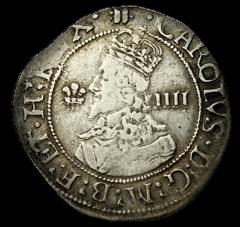
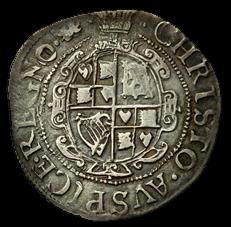
Aberystwyth Mint - Estimated Value 140 (2018)
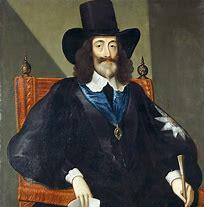
Charles I
Main Coin Menu

VIEW ALL MENUS
Member NCMD
6. S. Menu
























